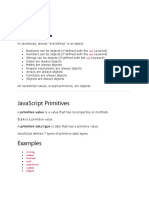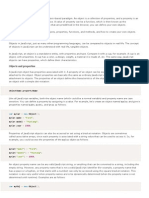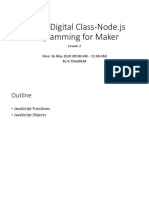0 ratings0% found this document useful (0 votes)
7 viewsJavaScript Object Essentials
The document provides an overview of JavaScript object essentials, including property access methods such as dot and bracket notation. It explains how objects can store functions as methods, the significance of 'this', and various object manipulation methods like Object.keys(), Object.values(), and Object.entries(). Additionally, it discusses cloning objects and accessing nested objects.
Uploaded by
bhupesh7500chauhanCopyright
© © All Rights Reserved
We take content rights seriously. If you suspect this is your content, claim it here.
Available Formats
Download as PDF or read online on Scribd
0 ratings0% found this document useful (0 votes)
7 viewsJavaScript Object Essentials
The document provides an overview of JavaScript object essentials, including property access methods such as dot and bracket notation. It explains how objects can store functions as methods, the significance of 'this', and various object manipulation methods like Object.keys(), Object.values(), and Object.entries(). Additionally, it discusses cloning objects and accessing nested objects.
Uploaded by
bhupesh7500chauhanCopyright
© © All Rights Reserved
We take content rights seriously. If you suspect this is your content, claim it here.
Available Formats
Download as PDF or read online on Scribd
You are on page 1/ 9
© JavaScript
JS
JavaScript
Object Essentials
@thecodecrumbs
www.codecrumbs.com
Property Access
Dot Notation: The most common way to access properties. If
you have an object person with a property name, you can
access it with person.name
Bracket Notation: Useful when property names are dynamic
or include characters that can't be used in dot notation.
Example: person["first name"]
@thecodecrumbs
www.codecrumbs.com 01
f~....
(© JavaScript
\ S pt )
Objects can store functions as properties. These functions
are typically called methods when associated with objects.
Within an object method, this refers to the object that the
method belongs to. However, the value of this can change
depending on the context in which a function is called.
const person = {
‘John',
: function () {
jello,
+ this.name + '
f~....
(© JavaScript )
a
Object Keys
Object.keys() Returns an array of an object's own enumerable
property names.
car = { make: ' ota’, model: ‘Camry’ };
console. log(Object.k s(car));
f~....
(© JavaScript )
a
Object Values
Object.values() Returns an array of an object's own
enumerable property values.
st car = { make: ‘Toyota’, model: ‘Camry’ };
console. log(Object.va s(car));
04
f~....
(© JavaScript )
i
Object Entries
Object.entries() Returns an array of [key, value] pairs for an
object.
car = { make: ‘Toyota’, model:
console. log(Object.entries(car)) ;
f~....
(© JavaScript )
a
Cloning Objects
Copying objects in JavaScript can be tricky since objects are
reference types. To create a shallow copy, you can use the
Object.assign() method or the spread operator.
t carCopy = Object.assign({}, car);
carCopy2
06
he
=,
© Javascript )
Objects can contain other objects, leading to a hierarchical
structure. Accessing nested objects requires chaining
property access.
const student
name: ‘Alex',
address: {
eB)
my \anaee) ae
console.
Outputs
Add to Favourites
How many do
you know?
@thecodecrumbs
www.codecrumbs.com
Leave a commer Save for later AI
You might also like
- A Comprehensive Guide to JavaScript Objects - Part 1No ratings yetA Comprehensive Guide to JavaScript Objects - Part 14 pages
- Learn JavaScript - Objects Cheatsheet - CodecademyNo ratings yetLearn JavaScript - Objects Cheatsheet - Codecademy10 pages
- 3JS-Part3 Objects, Properties, And Methods of the DOMNo ratings yet3JS-Part3 Objects, Properties, And Methods of the DOM85 pages
- Learn JavaScript - Objects Cheatsheet - CodecademyNo ratings yetLearn JavaScript - Objects Cheatsheet - Codecademy9 pages
- 9.Learn JavaScript_ Objects Cheatsheet _ CodecademyNo ratings yet9.Learn JavaScript_ Objects Cheatsheet _ Codecademy10 pages
- Learn JavaScript - Objects Cheatsheet - CodecademyNo ratings yetLearn JavaScript - Objects Cheatsheet - Codecademy10 pages
- Learn JavaScript - Objects Cheatsheet - CodecademyNo ratings yetLearn JavaScript - Objects Cheatsheet - Codecademy7 pages
- JavaScript - Arrays, Loops, and Objects - Objects Cheatsheet - CodecademyNo ratings yetJavaScript - Arrays, Loops, and Objects - Objects Cheatsheet - Codecademy7 pages
- Objects: Objects: The Basics Page 1 of 47No ratings yetObjects: Objects: The Basics Page 1 of 4747 pages
- Introduction To JavaScript Functions Arrays and ObjectsNo ratings yetIntroduction To JavaScript Functions Arrays and Objects8 pages
- A Comprehensive Guide to JavaScript Objects - Part 2No ratings yetA Comprehensive Guide to JavaScript Objects - Part 24 pages
- Object-Oriented Javascript: Stoyan Stefanov, Yahoo! Inc. Beijing, Dec 6, 2008No ratings yetObject-Oriented Javascript: Stoyan Stefanov, Yahoo! Inc. Beijing, Dec 6, 200874 pages
- 5 Ways To Add A Property To Object in Javascript: Contact MentorNo ratings yet5 Ways To Add A Property To Object in Javascript: Contact Mentor14 pages
- Javascript is the programming language of the webNo ratings yetJavascript is the programming language of the web16 pages
- Object Prototypes - Learn Web Development _ MDNNo ratings yetObject Prototypes - Learn Web Development _ MDN8 pages
- Object Oriented Javascript: © 2013, Cognizant Technology SolutionsNo ratings yetObject Oriented Javascript: © 2013, Cognizant Technology Solutions42 pages
- Web Design and Development Lecture 9 B - JavaScript AdvancedNo ratings yetWeb Design and Development Lecture 9 B - JavaScript Advanced34 pages

























































